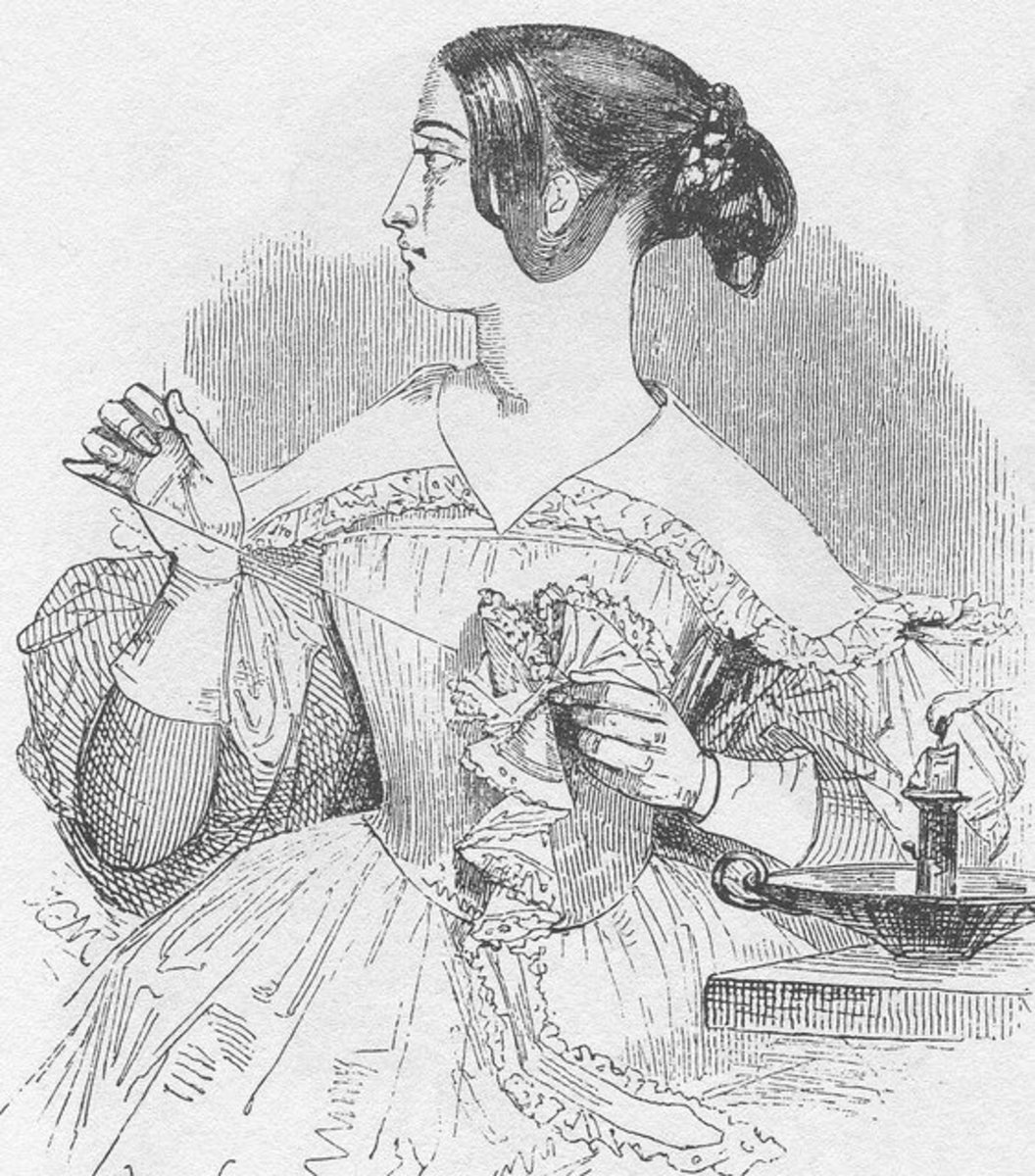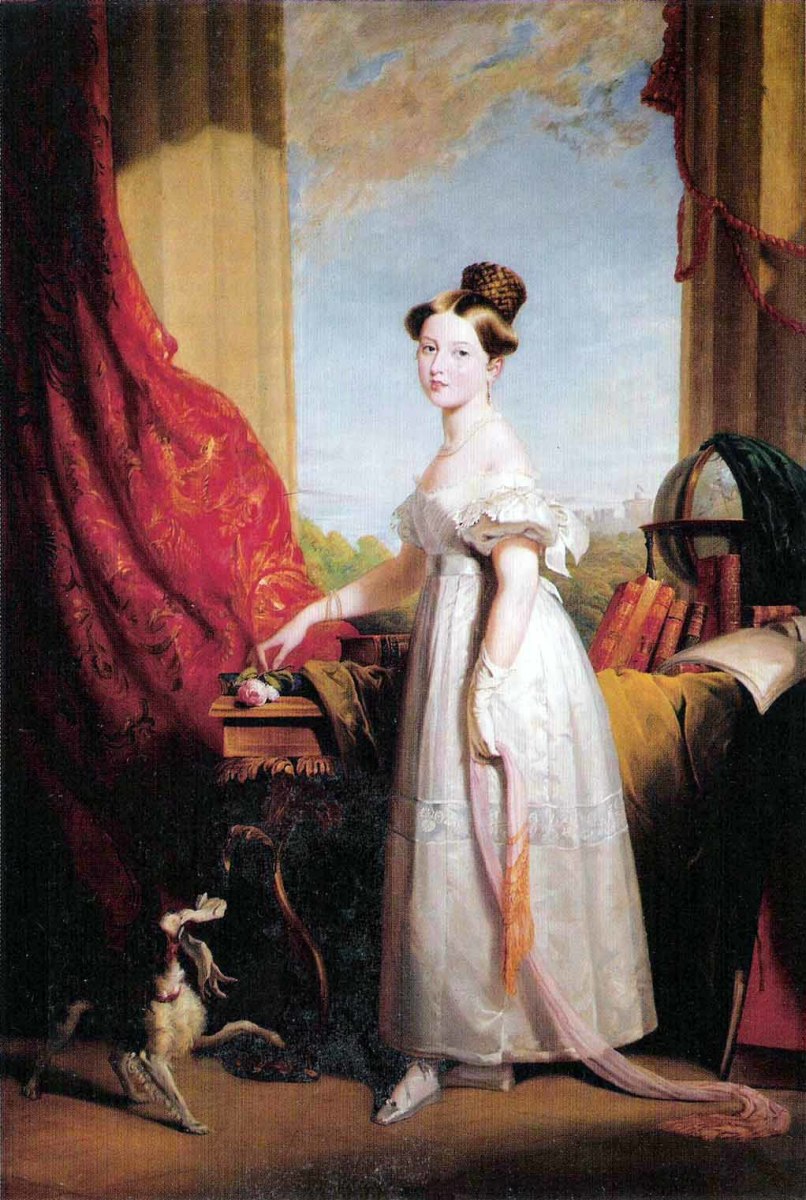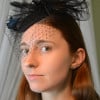Hair, as it happens, is an amazing indicator of time. Anyone can tell you this after going through old photo albums, looking at vintage advertisements, and watching old movies and television shows. Hair speaks volumes about certain decades- even specific years!
Now, I'm all for keeping up with fashion trends, but I also want to lessen the amount of times I cringe at dated hairstyles, so I have been researching completely off-trend styles: hairstyles from 100 years back or more.
While I expected most of these styles to be too strange for modern use, or too time-consuming to be practical, I was pleasantly surprised to find that many historical hairstyles are not only fetching, but completely doable! The Victorian era has some of the best. Let's have a look at the time period's predominant coiffures. Perhaps you can take one or two of them for a spin!

Source
Getting Loopy
As the Victorian period was in its infancy, it was popular for women to arrange their hair in an updo collected at the back of the head complimented by one or more loops of hair leading from the front of the hair to this arrangement at the back, sort of like a sash.
The fun thing about recreating this style is:
- It does not require a lot of effort.
- It is very unique: NOBODY wears their hair like this these days!
- It is an option for straight-hair ladies who do not feel like curling or crimping their hair.
Of course, this style is NOT ideal for the modern woman who moves around a lot (something proper Victorian ladies didn't have to worry about so much), nor is it all that feasible to those with curly hair (unless they might choose to braid those loops, which would look pretty cool), but it might be a fun choice for a quiet day- especially if you feel like trying something novel!

Princess Victoria in 1833 | Source
Queen Victoria's Hairstyles
It would be silly to discuss Victorian style without mentioning the influence of Queen Victoria.
When it comes to hair, this icon kept things pretty simple. In nearly all of her portraits, Princess, and later Queen Victoria, parted her hair down the center, looped her glossy hair around the sides, and secured what remained in an updo.
The most fancy style I've seen her exhibit involves piling her braids high on her head, but she seemed to do this mostly when she was younger. In one 1935 self-portrait she did as Princess of Kent (shown further down), Princess Victoria also sports some fancy curls at the side of her face, in addition to the braid-crown worn at the top of her head.
In her later years, Queen Victoria seems to have opted mostly for the simplest possible hairstyle, and is more often than not photographed with just a bit of tightly pulled back hair peeping out form under a veil, bonnet, or hat.

Source
Crimping
Hot irons were introduced as hair styling devices during the Victorian era, which resulted in the popularity of crimped updos.
One of these styles, known as the "Marcel Wave," involved using a hot iron on the hair to create a loose wavy updo, similar to that shown by the women in the image to the right.
The Victorian Era's predilection for accessories made a big difference when it came to the crimping style- the waves look great when tied back with combs, flowers, ribbons, and strings of beads.
The Victorian Mullet
One more thing that many Victorian women did with curling irons was cut the hair around their faces very short, and then crimp it, leaving a sort of curly fringe around their faces. I... I just can't condone this. I see it as the Victorian Mullet. Alas, you will see it make many an appearance in Victorian-era portraits.

Source
The Gibson Girl Style
Around the end of the 19th Century and the beginning of the 20th Century, a new feminine ideal emerged on the scene: the Gibson Girl. The Gibson Girl personified a much more independent, sporty, and simple type of woman, and her hairstyles were much more loose and carefree-looking than some of the Victorian era's more involved updos.
The Gibson Girl was often portrayed as wearing one of the following hairstyles:
- A chignon: This simple style involves tying the hair in a knot at the nape of the neck.
- The top bun: A loose bun tied at the very top of the head
- The psyche knot: Very similar to a high, normal bun
The gist of any Gibson-girl-inspired hairstyle is this: it must be effortless, simple, and graceful.

Princess Victoria of Kent, sporting curls in a self-portrait sketch from November 1845 | Source
Use of Curls
Curls had been stylish for decades and decades before the Victorian period ever began, but they certainly took a turn for the creative during this time.
Some Victorian use of curls was influenced by the Regency era, in which curls were often worn in medium coils that framed the face. This style is apparent in the self-portrait sketch of Princess Victoria, which was created before the Victorian era, which officially began in 1837.
Also in the early 19th Century, children were known to sport "sugar curls" or "barley curls" - long ringlets that hung down from the rest of their hair. During the latter half of the century, women began to adapt the style to their own updos, leaving one or two long curls hanging down from a more polished (or at least less haphazard than the Gibson Girl style) coiled bun or similarly twisty updo.
Re-creating this look is much easier today than it was back then! With the help of a curling iron and some hairspray, you can create a coiled lock of hair that will hold its form for several hours.
Fun with Braids
As is apparent from Princess Victoria's self-portrait, many of this time period's updos were complimented by braids, either as a finishing element or as a flourish.
To the right is a look at one hairstyle involving three braids and another take on the ever-so-popular looping that was going on during this time- all at the back of the head at this point.
As torrinpaige in the video points out, this hairstyle is good for people with hair as short as just-past-shoulder length, and it looks reasonably easy. I definitely recommend giving it a go!

Oh la la! | Source
What about letting hair down?
Long, loose hair, at least during Victorian times, was only appropriate for children, so if you're looking for a more free-flowing look, you may wish to consider reproducing some differenttime periods with your coiffure, since most respectable grown women only wore their hair down in very intimate settings: their bedroom or dressing room, for example.
That siad, loose hair during Victorian times, did have some interesting connotations. For example, in Denmark, long, lose hair marked a period between childhood and adulthood for young women.
Girls who were of marriageable age, but not engaged, would wear their hair down and without a hat or bonnet as a signal of their eligibility. Pretty cool, huh?
If you're not looking to advertise your eligibility, you can still get your way, at least partially, by braiding and styling hair at the front of your head and letting your hair in the back hang loose. This style saw some popularity during the 1870s, so by at least some Victorian standards, your style would not be too scandalous!

A depiction of fashionable hairstyles in the Danish "Punch," 1879 | Source

A Victorian hair comb from 1835 | Source
Let's Accessorize!
The Victorian period is one known for restricted opulence. During this time, people fought back against the forced simplicity of the Regency Era and really went to town with their clothing and accessories.
It should come as no surprise, then, that many victorian hairstyles were pretty bedazzled. Many of the time period's most classic updos would be considered incomplete without flowers, beautifully crafted ornaments, and elegant combs.
Women also wore hats during this time. It was common convention to wear some sort of head covering upon going outside, so most hairstyles would be covered! While that might seem like a shame, hats got pretty elaborate during this period, and were often complimented by impressive, supporting hairstyles beneath. While the hat depicted in the painting below is very simple, many hats from the time were embellished with lace, flowers, feathers, and veils, and had a sizable girth to accommodate for large updos.

Source
What's Your Opinion?
What Victorian Style do you like the best?
The Gist
If one were to sum up hairstyles worn during the Victorian period into just a couple details, they would be:
- Simple, smooth, and tight updos
- The more airy but swept up Gibson Girl updo
- Long coiled curls hanging from a loose chignon
- Crimped updos
- Closely-cropped and curled bangs (the Victorian mullet!!!)
And when one considers who complex hair from other periods has been, these styles are all quite reasonable! Which is your favorite?
Perhaps you might consider giving a nice top bun a try instead of going for today's most trendy hairstyles. I know I shall! We may have to live in the 21st Century, but we are by no means barred from enjoying our favorite styles from the past.



No comments:
Post a Comment